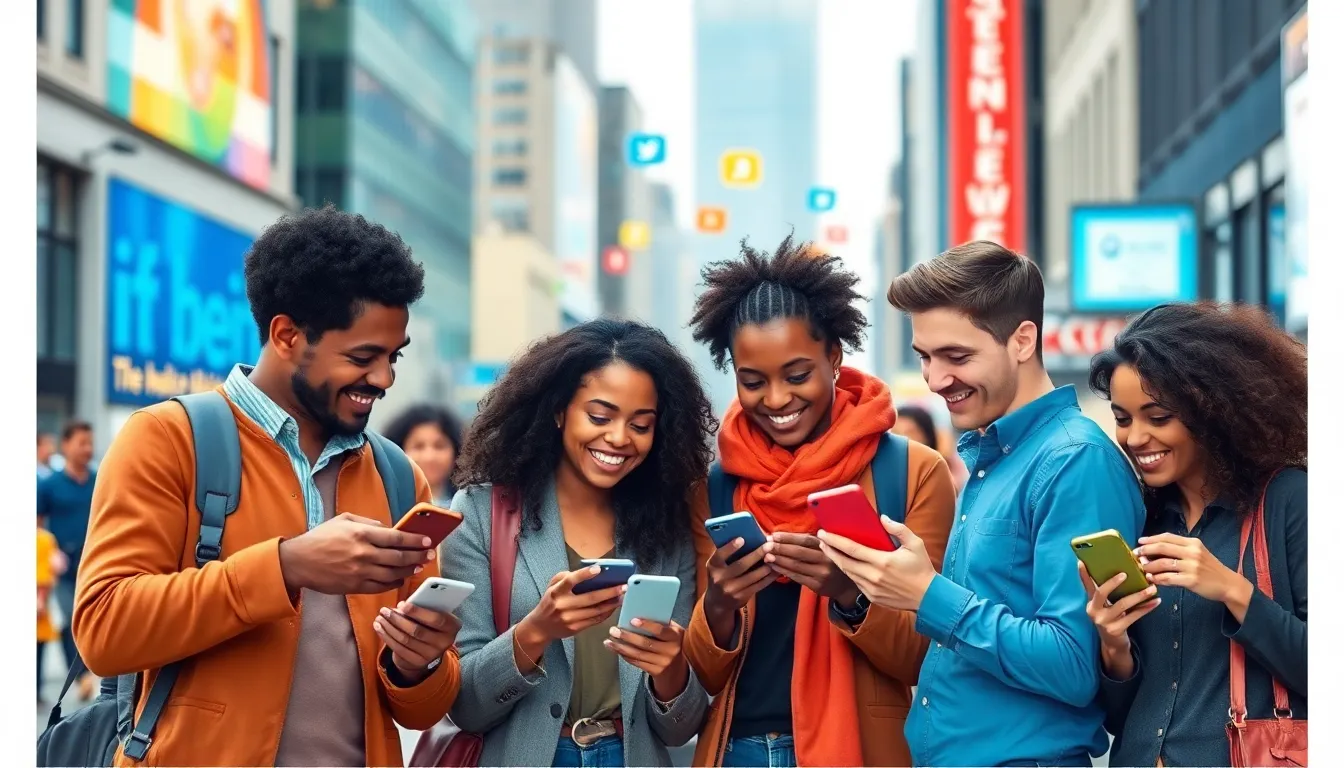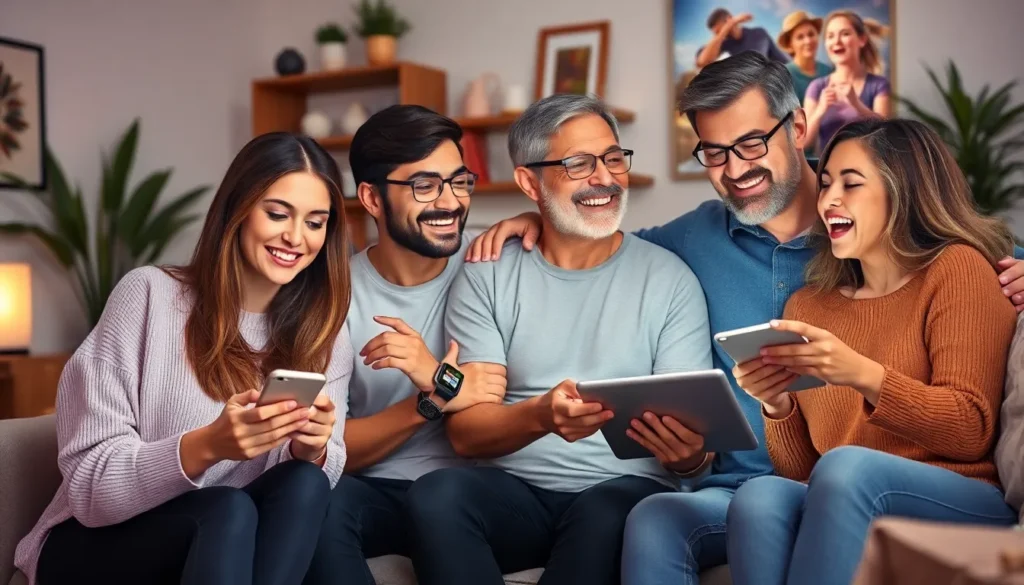In today’s fast-paced world, technology isn’t just a luxury; it’s practically a necessity. From the moment people wake up to the sound of their smartphone alarm to the late-night binge-watching sessions, tech weaves itself into every corner of life. It’s like that friend who overstays their welcome but somehow makes everything more interesting.
Imagine life without GPS guiding the way or online shopping saving a trip to the mall. Technology brings convenience, efficiency, and a sprinkle of fun to daily routines. As we dive into the 10 ways technology enhances our lives, get ready to appreciate the little gadgets and apps that keep life running smoothly—because who wouldn’t want a personal assistant that fits in their pocket?
Table of Contents
ToggleOverview of Technology in Daily Life
Technology plays a pivotal role in shaping everyday experiences. Users rely on smart devices for alarms, streamlined communication, and instant access to information. Smartphones serve multiple functions, acting as cameras, notebooks, and entertainment devices. People utilize smart home devices to manage energy consumption and enhance security effortlessly.
Health monitoring devices track fitness metrics, enabling individuals to maintain their wellness goals. Social media platforms foster connections across the globe, making it easy to share moments and stay in touch with friends. E-commerce apps facilitate shopping, offering convenience without the need to visit physical stores.
Online banking simplifies financial management, allowing users to transfer funds, pay bills, and monitor accounts from anywhere. Virtual assistants process voice commands to set reminders, control smart home devices, or search for information quickly. Educational technology provides learning resources, enriching access to knowledge through online courses and tutorials.
The integration of these technological solutions directly impacts routines. Daily tasks become more manageable, transforming how individuals approach work and leisure activities. The influence of technology continues to grow, reinforcing its importance as a cornerstone of modern life.
Communication

Technology transforms communication, making it quick and efficient. It facilitates interactions across the globe, creating connections that were once impossible.
Social Media
Social media platforms like Facebook, Twitter, and Instagram enable users to share updates, photos, and ideas instantly. These platforms connect people with friends, family, and even strangers who share common interests. Users engage in discussions, exchange opinions, and build communities around shared passions. Instant sharing of experiences fosters a sense of belonging and support. According to recent statistics, about 4.9 billion people use social media worldwide, illustrating its massive impact on communication.
Instant Messaging
Instant messaging apps like WhatsApp, Telegram, and Signal allow real-time conversations without barriers. Users can send texts, voice messages, and images instantly, enabling seamless exchanges. These apps support group chats, making collaboration easy for work or social planning. Security features like end-to-end encryption ensure conversations remain private. Approximately 60% of smartphone users prefer instant messaging over traditional SMS, highlighting its growing preference for daily communication.
Transportation
Technology significantly enhances transportation, making travel more efficient and convenient. From navigation to ride-sharing, it streamlines the entire experience.
Navigation Apps
Navigation apps like Google Maps and Waze provide real-time traffic updates. These applications help users find the quickest routes, avoiding traffic jams and road closures. Users rely on turn-by-turn directions, making unfamiliar locations feel accessible. Additional features include estimated arrival times and alternative routes, which optimize travel plans. Data shows that about 70% of drivers utilize navigation apps for daily commutes, emphasizing their essential role. These tools contribute to safer driving by guiding drivers and minimizing distractions from physical maps.
Ride-Sharing Services
Ride-sharing services such as Uber and Lyft revolutionize personal transportation. These platforms connect passengers with nearby drivers via mobile apps, allowing for quick and convenient rides. Users can schedule rides on-demand, catering to their immediate needs. Statistics indicate that the market for ride-sharing reaches over $200 billion worldwide, highlighting significant global adoption. Payment processing happens seamlessly within the app, eliminating cash transactions. Riders benefit from upfront pricing, increasing transparency in costs. Environmental advantages also exist, as shared rides reduce the number of vehicles on the road, contributing to lower emissions.
Health and Fitness
Technology significantly shapes health and fitness routines. It improves personal health management, making it accessible and efficient.
Wearable Technology
Wearable technology includes devices like fitness trackers and smartwatches. These gadgets monitor physical activity, heart rate, and sleep patterns. Individuals can gain insights into their daily habits through real-time data tracking. Recent studies indicate that approximately 32% of American adults own a wearable device, highlighting their popularity. Users can set fitness goals and receive notifications to encourage activity. Many wearables sync with smartphones, allowing for easy access to personalized health information. This integration fosters a healthier lifestyle by motivating users to stay active and informed.
Health Monitoring Apps
Health monitoring apps facilitate personal health management from the palm of a hand. These applications help track nutrition, exercise, and vital signs, offering a comprehensive view of overall health. For example, MyFitnessPal allows users to log meals and monitor calorie intake effectively. Approximately 54% of smartphone users utilize health apps to support their wellness journeys. Users can receive reminders for medication and appointments, promoting adherence to treatment plans. Integration with wearable devices further enhances their functionality, allowing seamless data exchange. These apps empower individuals to take charge of their well-being with data-driven insights.
Education
Technology plays a crucial role in education, transforming how students learn and access information. Online resources and tools enhance educational experiences and provide increased knowledge sharing.
Online Learning Platforms
Online learning platforms offer flexibility and accessibility for learners worldwide. Platforms like Coursera and edX provide courses from prestigious universities, allowing students to learn at their own pace. Millions of people enroll in these courses, reflecting a growing trend toward remote education. Interactive features, such as quizzes and discussion forums, engage learners actively. Furthermore, these platforms support a wide range of subjects, catering to diverse interests and educational backgrounds.
Educational Apps
Educational apps facilitate learning on the go and make knowledge acquisition engaging. Apps like Duolingo assist users in learning new languages through gamified experiences. More than 300 million users benefit from these learning tools. Other apps focus on subjects ranging from math to science, enhancing comprehension through interactive content and multimedia resources. These apps personalize the learning process, allowing users to track their progress and set goals. Thus, technology supports a more enriching educational experience.
Entertainment
Technology enhances entertainment through various platforms and mediums, making enjoyable content more accessible.
Streaming Services
Streaming services like Netflix and Hulu deliver a vast array of movies and television series instantly. Subscribers benefit from diverse genres and original programming, with over 238 million combined users worldwide. With the option to binge-watch entire seasons, viewers experience unprecedented flexibility in their viewing schedules. These platforms also personalize recommendations, helping users discover new shows based on their viewing habits. Moreover, many streaming services support multiple devices, ensuring that content is available on smartphones, tablets, and smart TVs, making entertainment seamless and portable.
Mobile Gaming
Mobile gaming significantly transforms entertainment experiences on the go. Millions of users engage in gaming through apps on their smartphones and tablets, with approximately 2.7 billion people playing mobile games globally. Diverse genres, including puzzles, strategy, and action, cater to various interests and age groups. Gamers often appreciate in-app purchases and multiplayer features, enhancing user engagement and social connections. With advancements in graphics and gameplay, mobile games continue to compete with traditional console experiences, making gaming more accessible and enjoyable for all.
Smart Home Devices
Smart home devices significantly enhance convenience and security in daily life. They automate routine tasks, creating a seamless living experience.
Home Automation
Home automation systems streamline household management through integrated devices. Smart lights adjust automatically based on occupancy, improving energy efficiency. Smart thermostats learn user preferences, optimizing heating and cooling schedules. Voice-activated assistants control various devices with simple commands, ensuring hands-free operation. These systems contribute to enhanced convenience, enabling users to manage their home environment remotely via smartphone applications.
Smart Security Systems
Smart security systems provide heightened protection and peace of mind. These devices include smart cameras that offer real-time video feeds, allowing users to monitor their property from anywhere. Motion detectors send instant alerts to smartphones when unusual activity occurs. Video doorbells let users see and communicate with visitors without opening the door. With features like remote locking and unlocking, these systems ensure secure access management, which appeals to many homeowners seeking comprehensive safety solutions.
Work and Productivity
Technology enhances work and productivity significantly, enabling individuals and teams to operate more efficiently.
Project Management Tools
Project management tools streamline workflows, making it easier for teams to organize tasks. Software like Trello and Asana allows users to track project progress visually through boards and lists. Collaboration features enable users to assign tasks to team members, set deadlines, and share updates instantly. About 77% of high-performing projects utilize project management tools, demonstrating their effectiveness. Integrating these solutions improves project transparency, ensuring everyone stays informed about progress and challenges.
Remote Collaboration Software
Remote collaboration software connects teams regardless of location, fostering seamless communication. Platforms such as Slack and Microsoft Teams facilitate instant messaging, file sharing, and video calls. Approximately 50% of employees engage with remote collaboration tools daily, highlighting their importance in modern work environments. These tools support project discussions and help mitigate the isolation often felt in remote work settings. Enhanced features such as screen sharing and collaborative document editing further boost team productivity, making teamwork achievable from anywhere.
Financial Management
Technology plays a vital role in financial management, with tools that simplify everyday tasks.
Mobile Banking
Mobile banking apps allow users to manage their finances with ease. Users can check balances, transfer funds, and pay bills anytime and anywhere. Incredibly, approximately 75% of American adults now utilize mobile banking services. These apps provide real-time notifications for transactions, ensuring users stay on top of their accounts. Security features like two-factor authentication enhance protection, making online banking safer. Many mobile banking platforms also offer budgeting tools, further integrating finance management into daily routines. With such convenience, there’s no surprise that mobile banking continues to grow in popularity.
Budgeting Apps
Budgeting apps provide effective solutions for tracking expenses and managing financial goals. Users can categorize spending, set spending limits, and monitor progress through user-friendly interfaces. Approximately 20% of American adults leverage these apps for personal finance management. Popular options include Mint, YNAB, and PocketGuard, each offering unique features tailored to different needs. These tools analyze spending patterns, helping users make informed decisions about their finances. Syncing with bank accounts ensures up-to-date information, simplifying budgeting even further. Through these applications, individuals gain better control over their financial lives.
Technology’s integration into daily life is undeniable and transformative. From enhancing communication to streamlining transportation and health management, its impact is felt in every aspect of modern living. As individuals continue to embrace these innovations, the convenience and efficiency they provide will only grow.
Smart devices and applications have become essential tools that simplify tasks and improve overall quality of life. As technology evolves, it will further shape how people connect, learn, and manage their daily activities. The future promises even greater advancements that will continue to redefine everyday experiences. Embracing these changes will empower individuals to navigate their lives with confidence and ease.




